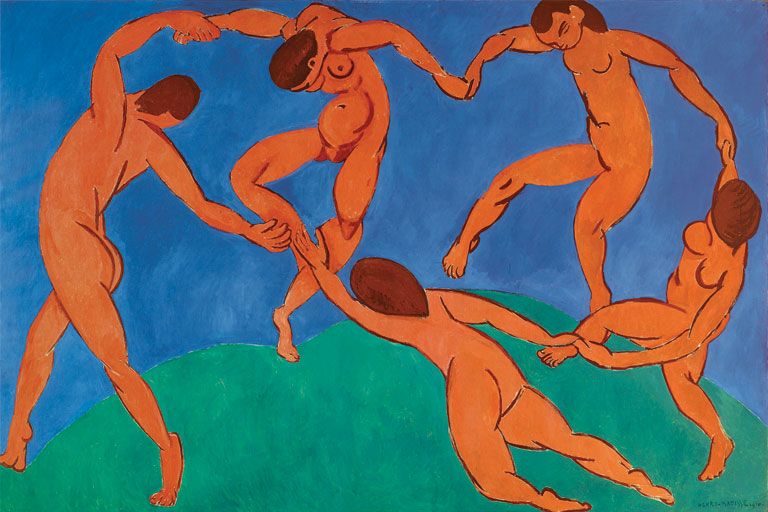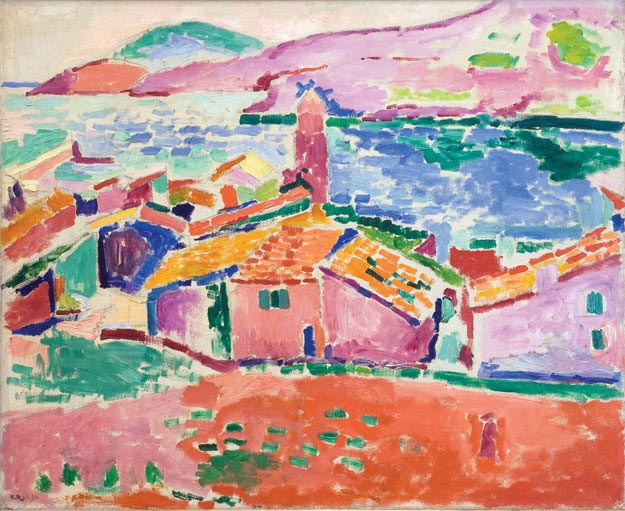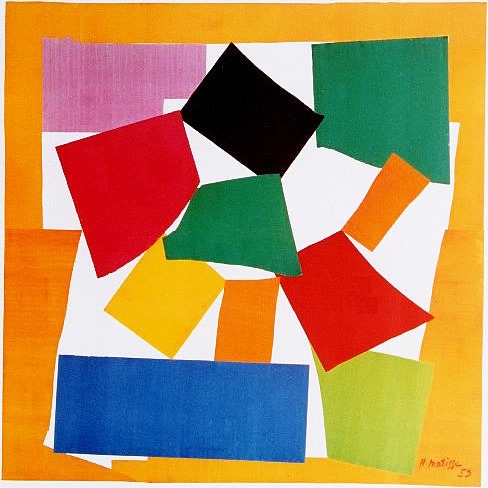 Matisse's Dance II (1910) has become one of the most famous images in modern art. Critics at the time found the canvas ugly and barbaric but could it inspire an outfit or two?
Matisse's Dance II (1910) has become one of the most famous images in modern art. Critics at the time found the canvas ugly and barbaric but could it inspire an outfit or two?Whenever Susie leaves the country I turn in to something of an insomniac and in addition to working on the blog, I find solace in BBC iplayer. When I've not been listening to the sounds of comfort that are BBC Radio 4 discussions, documentaries and plays I have been watching programmes I would have otherwise have missed. I watched one such show in the early hours of Monday morning, Modern Masters. During this vibrant hour long programme journalist Alastair Sooke explains why Henri Matisse's art is considered so great and also looks at how his brilliant use of colour and simplification of form continues to inspire illustrators, designers, artists and of course myself today. It is Matisse's revolutionary use of colour and his balance of pattern that whet my sartorial appetite.
 Matisse's The Roofs of Collioure (1905) uses colour to convey an emotional response to the landscape rather than a faithful representation of the scene itself.
Matisse's The Roofs of Collioure (1905) uses colour to convey an emotional response to the landscape rather than a faithful representation of the scene itself."With colour one obtains an energy that seems to stem from witchcraft." Matisse
Matisse pioneered a revolutionary use of colour and form and dispensed with traditional art techniques, refusing to accept that colour must reflect the real world. Matisse knew and used the below colour wheel extremely well. It was put together in the 1830s by a French scientist called Chevreul after investigating how the human eye sees colour. Complementary colours can be found by finding two colours situated opposite from each other on wheel. As many of his artistic peers became fascinated with using yellow and blue, Matisse moved around the wheel, jarring colours to quickly become a 'bad boy' of French art. Matisse was a pioneer not only of colour, but also of pattern. In addition to requiring gazers eyes to be shielded from the bright hues, Matisse was able to balance seemingly disparate elements cohere. He was able to harmonise masses of colour with a relief of neutral shades of black, white and navy. Certainly a lesson to be learned and experimented with in the warm months ahead.
 Chevreul's colour wheel can offer a great deal of sartorial play much in the same way as Matisse experimented with colour in his artwork.
Chevreul's colour wheel can offer a great deal of sartorial play much in the same way as Matisse experimented with colour in his artwork.Acknowledging the debt the famous couturier Yves St Laurent owed the painter, Sooke also talks to British designers Sir Paul Smith and Tricia Guild about their passion for Matisse. For Smith, Matisse is the 'boss of colour' and confessed that he has used his famous Snail as inspiration for colour, stripes and pattern. Ever since he became a designer, Smith has nudged men towards a wardrobe of Matisse colours. Smith isn’t the only designer to be inspired by Matisse. Yves Saint Laurent, who used to say that he wished he had been Matisse, made a number of dresses suffused with the spirit of the French artist. Sooke also travels to Utrecht to discover how even children's character Miffy the rabbit owes its origin to art, and reveals how logos and images as diverse as Apple's iPod advertising and even the 2012 olympic logo are inspired by the modern master.
 The Snail (1953). By the time that Matisse created The Snail, he was 83 years old and confined to his bed. The work is large, nearly three metres square, and showcases Matisse's brilliance at harmonising disparate colours and shapes so that the blocks of colour appear to float, as though always in motion.
The Snail (1953). By the time that Matisse created The Snail, he was 83 years old and confined to his bed. The work is large, nearly three metres square, and showcases Matisse's brilliance at harmonising disparate colours and shapes so that the blocks of colour appear to float, as though always in motion.This series aims to do two things, firstly to introduce to as wide an audience as possible the extraordinary lives and work of four titans of 20th-century art in Henri Matisse, Picasso, Salvador Dalí and Warhol and secondly to demonstrate that modern art has shaped, and still saturates, our everyday world. The more you look, the more you realise that modern art is everywhere. I'd like to consciously let my wardrobe be influenced by one or two of these modern masters. It has already begun with the recently acquired African print handkerchief from the Darkroom, it will continue with the purchase of Albam's orange canvas shopper (which tempted me below) and I'll report back when I can create an ensemble that would make Matisse smile.

3 comments:
this episode was brilliant, i loved every minute of it. the use of block colour was just perfect. and i want one of those ties like in the PS collection.
can't wait for my all time fa, dali!
I love Matisse. His Fauvist work is also amazing. It's really nice to see a post about art in this blog. :)
I wish I has a chance to see those documentaries about art. You ppl are very lucky :)
he made cut and paste cool. And his attention to curve is amazing.
JD
iplayfaves.blogspot.com
Post a Comment